[Pass Ensure VCE Dumps] Real Exam Microsoft 70-460 Braindumps And PDF Questions Help 100 Percent Passing Exam (31-45)
70-460 Exam 100% Pass Study Guide: PassLeader provides the newest 70-460 vce exam dumps updated in recent days with total 94q exam questions, it is the best study materials for preparing 70-460 certification exams. PassLeader's 70-460 94q vce or pdf dumps will offer you the latest exam questions and answers with free VCE and PDF file to download, which will help you 100% passing 70-460 exam. And PassLeader also supply the newest free version VCE Player now! keywords: 70-460 exam,70-460 94q exam dumps,70-460 exam questions,70-460 pdf dumps,70-460 vce dumps,70-460 94q braindump,Transition Your MCITP: Business Intelligence Developer 2008 to MCSE: Business Intelligence Exam 
QUESTION 31
You are designing a SQL Server Analysis Services (SSAS) cube. You need to create a measure to count unique customers. What should you do? A. Use role playing dimensions.
B. Use the Business Intelligence Wizard to define dimension intelligence.
C. Add a measure that uses the Count aggregate function to an existing measure group.
D. Add a measure that uses the DistinctCount aggregate function to an existing measure group.
E. Add a measure that uses the LastNonEmpty aggregate function. Use a regular relationship between the time dimension and the measure group.
F. Add a measure group that has one measure that uses the DistinctCount aggregate function.
G. Add a calculated measure based on an expression that counts members filtered by the Exists and NonEmpty functions.
H. Add a hidden measure that uses the Sum aggregate function. Add a calculated measure aggregating the measure along the time dimension.
I. Create several dimensions. Add each dimension to the cube.
J. Create a dimension. Then add a cube dimension and link it several times to the measure group.
K. Create a dimension. Create regular relationships between the cube dimension and the measure group. Configure the relationships to use different dimension attributes.
L. Create a dimension with one attribute hierarchy. Set the IsAggregatable prooerty to False and then set the DefaultMember property. Use a regular relationship between the dimension and measure group.
M. Create a dimension with one attribute hierarchy. Set the IsAggregatable property to False and then set the DefaultMember property. Use a many-to-many relationship to link the dimension to the measure group.
N. Create a dimension with one attribute hierarchy. Set the ValueColumn property, set the IsAggregatable property to False, and then set the DefaultMember property. Configure the cube dimension so that it does not have a relationship with the measure group. Add a calculated measure that uses the MemberValue attribute property.
O. Create a new named calculation in the data source view to calculate a rolling sum. Add a measure that uses the Max aggregate function based on the named calculation. Answer: F QUESTION 32
You administer a SQL Server Reporting Services (SSRS) instance in native mode. You need to assign a predefined role that meets the following requirements:
- Members of the role must be able to update shared data sources.
- Members of the role must not be able to consume reports or manage subscriptions.
- The role must provide only the minimum permissions required.
Which role should you assign? (More than one answer choice may achieve the goal. Select the BEST answer.) A. the Content Manager role
A. the Read and Process role
B. the Publisher role
D. the Browser role Answer: C QUESTION 33
Drag and Drop Questions
You are designing a SQL Server Reporting Services (SSRS) solution. An existing report aggregates data from a SQL Azure database in a chart. You need to use the chart in a new report and ensure that other users can use the chart in their reports. Which three actions should you perform in sequence? (To answer, move the appropriate actions from the list of actions to the answer area and arrange them in the correct order,)

Answer:
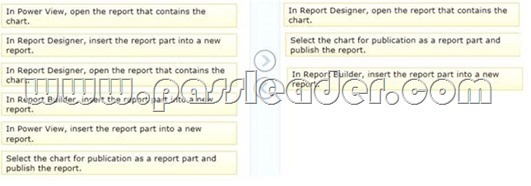 QUESTION 34
You are designing a subscription strategy for a SQL Server Reporting Services (SSRS) report. You have an application that populates a table with user-specific subscription schedules and report formats. You need to ensure that users can receive reports by email according to their preferences. What should you do? (More than one answer choice may achieve the goal. Select the BEST answer.) A. Create a standard subscription for each record in the table.
B. Create a data-driven subscription for each record in the schedule table.
C. Create one data-driven subscription. Schedule the subscription to frequently retrieve user preferences.
D. Create a standard subscription for each subscription schedule. Answer: C QUESTION 35
You are designing a strategy for an enterprise reporting solution that uses SQL Server Reporting Services (SSRS). Many of the SSRS reports will use common utilities and functions, including the following:
- Report utility functions and business logic in code
- Standardized report formatting properties such as fonts and colors for report branding Formatting may change and new functions may be added as the reporting solution evolves.
You need to create a strategy for deploying the formatting and code across the entire enterprise reporting solution. You must also ensure that reports can be easily updated to reflect formatting and function changes. What should you do? (More than one answer choice may achieve the goal. Select the BEST answer.) A. Create a report as a template. Apply standardized formatting to the template. Store code in the Code section of the template.
B. Build a web service that retrieves formatting properties and runs code. Call the web service through a report dataset.
C. Store the formatting properties and code in database objects. Use stored procedures to populate a default value for report parameters and map each parameter to a corresponding formatting property.
D. Create an assembly that contains formatting properties and code. Deploy the assembly on the Reporting Server and reference the assembly from each report. Answer: D QUESTION 36
Drag and Drop Questions
You are designing a dataset for a SQL Server Reporting Services (SSRS) report. The report includes the report items displayed in the following graphic.

The dataset is sourced from a commonly used stored procedure in an inventory data mart hosted in a SQL Azure database. It returns the status for all products across all storage sites. The report must display data for the storage site that is selected by the Site report parameter. You cannot change the stored procedure code. You need to filter the dataset to use only data specific to the selected site. How should you configure the filter? To answer, drag the appropriate expression or expressions to the correct location or locations in the answer area. (Answer choices may be used once, more than once, or not all.)
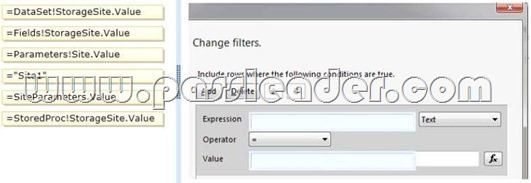 Answer:
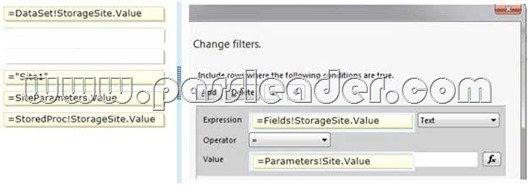 QUESTION 37
You are creating a Multidimensional Expressions (MDX) calculation for Projected Revenue in a cube. For Customer A, Projected Revenue is defined as 150 percent of the Total Sales for the customer. For all other customers, Projected Revenue is defined as 110 percent of the Total Sales for the customer. You need to calculate the Projected Revenue as efficiently as possible. Which calculation should you use? (More than one answer choice may achieve the goal. Select the BEST answer.)
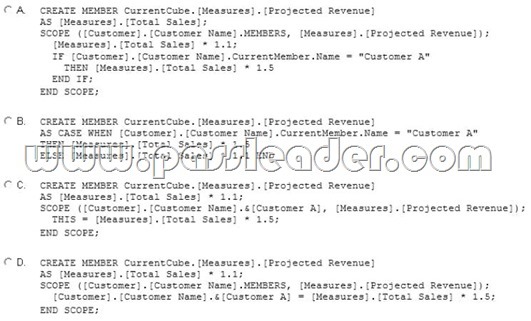 A. Option A
B. Option B
C. Option C
D. Option D Answer: C

http://www.passleader.com/70-460.html QUESTION 38
You are modifying a star schema data mart that feeds order data from a Microsoft Azure SQL Database database into a SQL Server Analysis Services (SSAS) cube. The data mart contains two large tables that include flags and indicators for some orders. There are 100 different flag columns, each with 10 different indicator values. Some flags reuse indicators. The tables both have a granularity that matches the fact table.You have the following requirements:
- Allow users to slice data by all flags and indicators.
- Modify the date dimension table to include a surrogate key of a numeric data type and add the surrogate key to the fact table.
- Use the most efficient design strategy for cube processing and queries.
You need to modify the schema. What should you do? (More than one answer choice may achieve the goal. Select the BEST answer.) A. Define the surrogate key as an INT data type. Combine the distinct flag/indicator combinations into a single dimension.
B. Define the surrogate key as an INT data type. Create a single fact dimension in each table for its flags and indicators.
C. Define the surrogate key as a BIGINT data type. Combine the distinct flag/indicator combinations into a single dimension.
D. Define the surrogate key as a BIGINT data type. Create a single fact dimension in each table for its flags and indicators. Answer: A QUESTION 39
Hotspot Questions
You are developing a SQL Server Analysis Services (SSAS) cube. A dimension named Category is based on the DimCategory table. A subset of the data source view is shown in the following graphic.
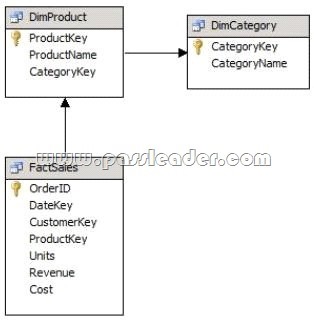
You need to relate the Category dimension to the Sales measure group. Which relationship type should you choose? To answer, select the appropriate option from the drop-down list in the dialog box.
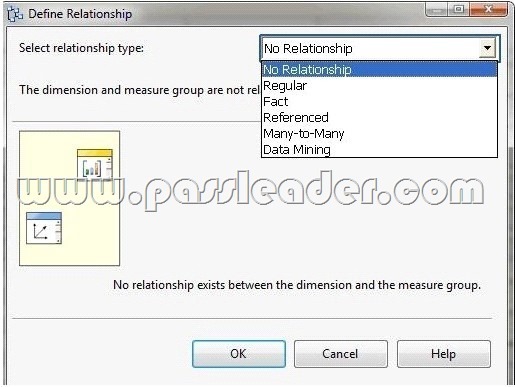 Answer:
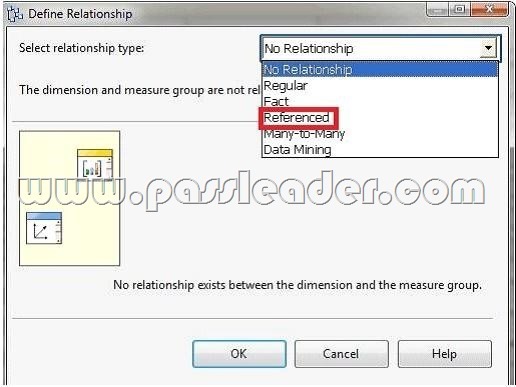 QUESTION 40
You are designing a SQL Server 2012 Integration Services (SSIS) deployment strategy. The production environment includes SSIS 2012 and SSIS 2008. The environment includes existing command shell scripts that invoke the dtutil command-line utility. You need to design a deployment strategy that supports existing deployment strategies and requires the minimum amount of effort. What should you do? (More than one answer choice may achieve the goal. Select the BEST answer.) A. Use a package deployment model. Change the command shell scripts to reference the SQL Server 2012 path to dtutil.
B. Use a project deployment model. Use the Integration Services Deployment Wizard.
C. Use a project deployment model. Use an indirect configuration. Change the command shell scripts to reference the SQL Server 2012 path to dtutil.
D. Use a package deployment model. Use an indirect configuration. Use the Integration Services Deployment Wizard. Answer: A Case Study: 1 - Tailspin Toys A (QUESTION 41 - QUESTION 45)
Background
You are the business intelligence (BI) solutions architect for Tailspin Toys. You produce solutions by using SQL Server 2012 Business Intelligence edition and Microsoft SharePoint Server 2010 Service Pack 1 (SP1) Enterprise edition.
Technical Background
Data Warehouse
The data warehouse is deployed on a SQL Server 2012 relational database. A subset of the data warehouse schema is shown in the exhibit. (Click the Exhibit button.)

The schema shown does not include the table design for the product dimension. The schema includes the following tables:
- The FactSalesPlan table stores data at month-level granularity. There are two scenarios: Forecast and Budget.
- The DimDate table stores a record for each date from the beginning of the company's operations through to the end of the next year.
- The DimRegion table stores a record for each sales region, classified by country. Sales regions do not relocate to different countries.
- The DimCustomer table stores a record for each customer.
- The DimSalesperson table stores a record for each salesperson. If a salesperson relocates to a different region, a new salesperson record is created to support historically accurate reporting. A new salesperson record is not created if a salesperson's name changes.
- The DimScenario table stores one record for each of the two planning scenarios.
All relationships between tables are enforced by foreign keys. The schema design is as denormalized as possible for simplicity and accessibility. One exception to this is the DimRegion table, which is referenced by two dimension tables. Each product is classified by a category and subcategory and is uniquely identified in the source database by using its stock-keeping unit (SKU). A new SKU is assigned to a product if its size changes. Products are never assigned to a different subcategory, and subcategories are never assigned to a different category. Extract, transform, load (ETL) processes populate the data warehouse every 24 hours.
ETL Processes
One SQL Server Integration Services (SSIS) package is designed and developed to populate each data warehouse table. The primary source of data is extracted from a SQL Azure database. Secondary data sources include a Microsoft Dynamics CRM 2011 on-premises database. ETL developers develop packages by using the SSIS project deployment model. The ETL developers are responsible for testing the packages and producing a deployment file. The deployment file is given to the ETL administrators. The ETL administrators belong to a Windows security group named SSISOwners that maps to a SQL Server login named SSISOwners.
Data Models
The IT department has developed and manages two SQL Server Analysis Services (SSAS) BI Semantic Model (BISM) projects: Sales Reporting and Sales Analysis. The Sales Reporting database has been developed as a tabular project. The Sales Analysis database has been developed as a multidimensional project. Business analysts use PowerPivot for Microsoft Excel to produce self-managed data models based directly on the data warehouse or the corporate data models, and publish the PowerPivot workbooks to a SharePoint site. The sole purpose of the Sales Reporting database is to support business user reporting and ad-hoc analysis by using Power View. The database is configured for DirectQuery mode and all model queries result in SSAS querying the data warehouse. The database is based on the entire data warehouse. The Sales Analysis database consists of a single SSAS cube named Sales. The Sales cube has been developed to support sales monitorinq, analvsis, and planning. The Sales cube metadata is shown in the following graphic.
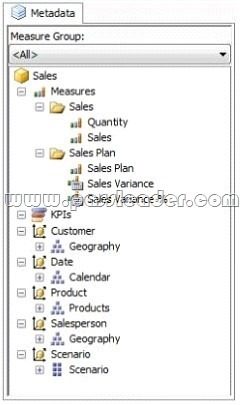
Details of specific Sales cube dimensions are described in the following table.

The Sales cube dimension usage is shown in the following graphic.
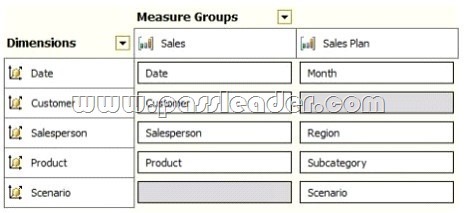
The Sales measure group is based on the FactSales table. The Sales Plan measure group is based on the FactSalesPlan table. The Sales Plan measure group has been configured with a multidimensional OLAP (MOLAP) writeback partition. Both measure groups use MOLAP partitions, and aggregation designs are assigned to all partitions. Because the volumes of data in the data warehouse are large, an incremental processing strategy has been implemented. The Sales Variance calculated member is computed by subtracting the Sales Plan forecast amount from Sales. The Sales Variance % calculated member is computed by dividing Sales Variance by Sales. The cube's Multidimensional Expressions (MDX) script does not set any color properties.
Analysis and Reporting
SQL Server Reporting Services (SSRS) has been configured in SharePoint integrated mode. A business analyst has created a PowerPivot workbook named Manufacturing Performance that integrates data from the data warehouse and manufacturing data from an operational database hosted in SQL Azure. The workbook has been published in a PowerPivot Gallery library in SharePoint Server and does not contain any reports. The analyst has scheduled daily data refresh from the SQL Azure database. Several SSRS reports are based on the PowerPivot workbook, and all reports are configured with a report execution mode to run on demand. Recently users have noticed that data in the PowerPivot workbooks published to SharePoint Server is not being refreshed. The SharePoint administrator has identified that the Secure Store Service target application used by the PowerPivot unattended data refresh account has been deleted.
Business Requirements
ETL Processes
All ETL administrators must have full privileges to administer and monitor the SSIS catalog, and to import and manage projects.
Data Models
The budget and forecast values must never be accumulated when querying the Sales cube. Queries should return the forecast sales values by default. Business users have requested that a single field named SalespersonName be made available to report the full name of the salesperson in the Sales Reporting data model. Writeback is used to initialize the budget sales values for a future year and is based on a weighted allocation of the sales achieved in the previous year.
Analysis and Reporting
Reports based on the Manufacturing Performance PowerPivot workbook must deliver data that is no more than one hour old. Management has requested a new report named Regional Sales. This report must be based on the Sales cube and must allow users to filter by a specific year and present a grid with every region on the columns and the Products hierarchy on the rows. The hierarchy must initially be collapsed and allow the user to drill down through the hierarchy to analyze sales. Additionally, sales values that are less than $5000 must be highlighted in red.
Technical Requirements
Data Warehouse
Business logic in the form of calculations should be defined in the data warehouse to ensure consistency and availability to all data modeling experiences. The schema design should remain as denormalized as possible and should not include unnecessary columns. The schema design must be extended to include the product dimension data.
ETL Processes
Package executions must log only data flow component phases and errors.
Data Models
Processing time for all data models must be minimized. A key performance indicator (KPI) must be added to the Sales cube to monitor sales performance. The KPI trend must use the Standard Arrow indicator to display improving, static, or deteriorating Sales Variance ?o values compared to the previous time period.
Analysis and Reporting
IT developers must create a library of SSRS reports based on the Sales Reporting database. A shared SSRS data source named Sales Reporting must be created in a SharePoint data connections library. QUESTION 41
Drag and Drop Questions
You need to extend the schema design to store the product dimension data. Which design should you use? To answer, drag the appropriate table or tables to the correct location or locations in the answer area. (Fill from left to right. Answer choices may be used once, more than once, or not all.)
 Answer:
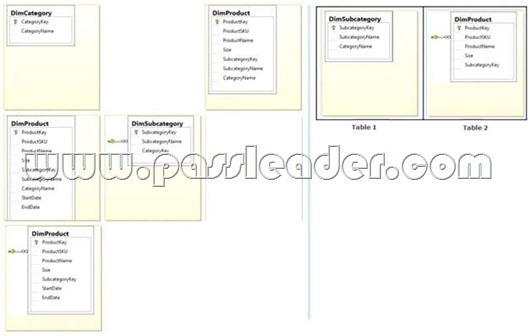 QUESTION 42
You need to configure the Scenario attribute to ensure that business users appropriately query the Sales Plan measure. What should you do? (Each correct answer presents part of the solution. Choose all that apply.) A. Set the AttributeHierarchyVisible property to False.
B. Set the IsAggregatable property to False.
C. Set the Usage property to Parent.
D. set the DefaultMember property to the Forecast member.
E. Set the AttributeHierarchyEnabled property to False.
F. Set the RootMemberIf property to ParentIsMissing. Answer: CD QUESTION 43
You need to grant appropriate permissions to the SSISOwners SQL Server login. What should you do? A. Map the login to the SSISDB database.
Assign the user to the ssis_admin role.
B. Map the login to the msdb database.
Assign the user to the db_owner role.
C. Map the login to the msdb database.
Assign the user to the db_ssisadmin role.
D. Map the login to the SSISDB database.
Assign the user to the db_ssisadmin role.
E. Map the login to the SSISDB database.
Assign the user to the db_owner role.
F. Map the login to the msdb database.
Assign the user to the ssis_admin role. Answer: C QUESTION 44
You need to define the trend calculation for the sales performance KPI. Which KPI trend MDX expression should you use?
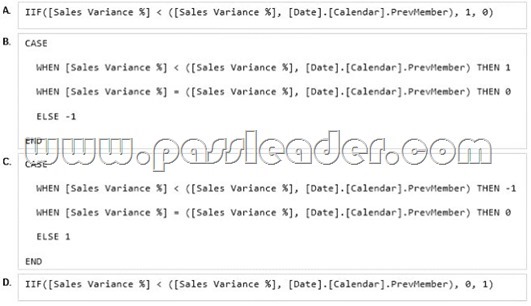 A. Option A
B. Option B
C. Option C
D. Option D Answer: B QUESTION 45
Drag and Drop Question
You need to configure the attribute relationship types for the Salesperson dimension. Which configuration should you use? To answer, drag the appropriate pair of attributes and attribute relationships from the list to the correct location or locations in the answer area. (Answer choices may be used once, more than once, or not all.)
 Answer:


http://www.passleader.com/70-460.html
|


















